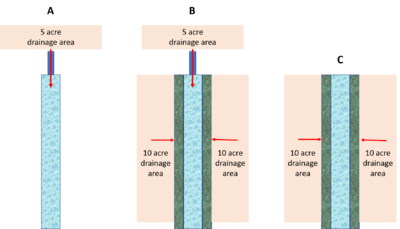
Routing stormwater runoff to swales and swale side slopes in the MIDS Calculator
The Minimal Impact Design Standards (MIDS) Calculator separates side slopes and the main channel of swales into separate practices. This creates the potential for inaccurately routing water, since in reality side slopes and main channels are part of a single swale system. This page provides guidance for routing water to swales in the MIDS Calculator.
Contents
Swale configuration in the MIDS Calculator
The MIDS Calculator separates swale side slopes and swale main channels into separate best management practices. This is because infiltration and pollutant retention calculations differ for the side slope and the main channel. Descriptions of modeling assumptions and calculations are found at the following links.
The primary difference between side slopes and main channels is due to increased potential for infiltration in a main channel resulting from different configurations. Specifically, infiltration in a main channel is affected by length of the swale, presence or absence of impermeable check dams, and presence or absence of engineered media. These configurations are either not available for side slopes or have limited impact on infiltration.
Potential swale configurations

In reality, swale side slopes and main channels are part of a single swale practice. There are three possible configurations of swales. Configuring and routing water to them correctly is essential to correctly modeling swales.
- Swale main channels with direct discharge to it and no side slopes. This situation is rare, but there may be situations where water is discharged, such as from a pipe, directly into a swale and the swale has no side slopes.
- Swale main channels with direct discharge to it and one or more side slopes.
- Swale main channels with one or more side slopes and no direct discharges to the swale.
These configurations are shown in the adjacent image.
Configuring and routing water to a swale practice
- Swale main channels with direct discharge to it and no side slopes. In this situation, only the swale main channel is used in the MIDS Calculator.
- If the discharge water to the swale main channel is coming directly from another treatment practice, such as a bifiltration practice (e.g. bioretention with an underdrain), do not enter any contributing pervious or impervious acreage to the swale main channel. Make sure the upstream practice is being routed to the swale main channel.
- If the discharge water to the swale main channel is not from another treatment practice, enter the impervious and pervious acres contributing to this discharge into the Watershed tab for the swale BMP properties.
- If the discharge water to the swale main channel contains both treated and untreated water, enter only acreages contributing to the untreated discharge. Make sure the upstream BMP for the treated water is routed to the swale main channel.
- Swale main channels with direct discharge to it and one or more side slopes. For this situation, apply the above methodology to the direct discharge to the main channel. For the side slope, enter pervious and impervious acres to the Watershed tab for the swale side slope and route the side slope to the main channel. DO NOT ROUTE THESE ACREAGES TO THE MAIN CHANNEL. If there is more than one side slope, use multiple side slopes routed to the one main channel.
- Swale main channels with one or more side slopes and no direct discharges to the swale. If all the discharge to the main channel is from swale side slopes, enter pervious and impervious acres to the Watershed tab for the swale side slope and route the side slope to the main channel. DO NOT ROUTE THESE ACREAGES TO THE MAIN CHANNEL. If there is more than one side slope, use multiple side slopes routed to the one main channel.
Examples
Categroy:Level 3 - Best management practices/Structural practices/Wet swale
This page was last edited on 23 November 2022, at 19:06.